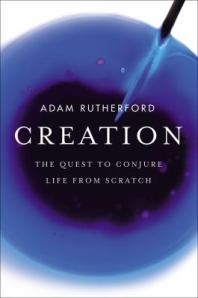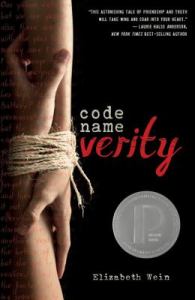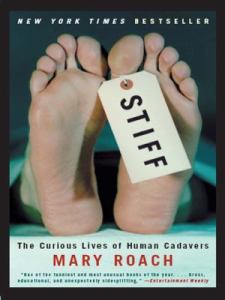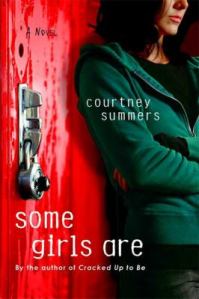Posted in Uncategorized | Tagged adult books for teens, YA fiction, YA literature | Leave a Comment »
 Creation: How Science is Reinventing Life Itself by Adam Rutherford
Creation: How Science is Reinventing Life Itself by Adam Rutherford
Here’s a book title that I was surprised to find is not hyperbole. Science really is creating new life forms. Rutherford doesn’t mean cloning life forms we know. He means altering the structure and components of DNA and coming up with odd hybrids of life—such as a goat that excretes spider web silk in its milk.
The sorts of stories Rutherford tells are the ones that science fiction has often warned against, the monsters that come from the imagination of our Frankensteins. So, should we be afraid?
Rutherford, a geneticist, a writer and editor of the prestigious science journal Nature, and a presenter of programs for the BBC in the United Kingdom, is not particularly worried about the gains scientists have made in creating life. He regards this as “a golden age in biology.” This book, in part, takes the time to reassure the reader that all will be well. To do so, Rutherford even contends that the world’s best-known bogeymen (think Monsanto, for example) are not empowered to wreak havoc on our planet’s future.
Rutherford makes a good case for synthetic biology and synthetic genetics, but before he does, he reviews what is known about life and its origins. We take the tour of the history of life starting with the big bang and Higgs Boson (and the current experiment with the Large Hadron Collider to re-create that big bang), tour the development of the cell (and how mitochondria within cells point to a common origin of all life forms), and move through the structure of DNA, again, with a discussion of the evidence of a common origin for all life forms.
In addition, what it means to be alive is defined—well, sort of. A handy definition is “Life is a process that stops your molecules from simply decaying into more stable forms.” But I do like the longer version explaining Schrodinger’s argument; “Living systems are the continual maintenance of energy imbalance. In essence, life is the maintenance of disequilibrium, and energy as life uses it is derived from this inequity. . . . The entropy of the universe is bound only to increase, thereby ultimately creating a more balanced but less ordered existence.” Sounds almost philosophical, doesn’t it?
Rutherford tells the reader that “synthetic biology means different things to different people,” but explores it by looking at the world as a toolbox full of tools provided by evolution that are then available for creating new life-forms. One of the ways of creating these new life-forms is by altering DNA. DNA is shown to be a “data storage device” and scientists can now alter the available data.
Interesting discussions of examples of synthetic biology include “Synthia,” a single synthetic cell created in 2010, and “Freckles” the goat, with her golden orb-weaver spider genetic code, which causes her milk to have spider silk in it. Of course, Rutherford discusses the value of these things—spider webs have important properties (they are very elastic and strong) that may be very useful in many applications.
There are reasons for man to explore changes in both plant and animal life. They have to do with feeding a hungry world as less and less land is arable in a more extreme global climate, and with medical advances that will save lives. But whether you agree with Rutherford that these changes are harbingers of a golden age or whether you want everything to go back to organic, it is important to know what is happening in our world. And Creation is a good place to start finding out.
High school housekeeping: I read this book partly because I am a curious creature and want to know about synthetic biology, but partly because I think it is exactly the kind of book that the designers of the Common Core are hoping you’ll read—an ‘informational text’ if you will, one that has facts that could prove very useful to you.
Creation is very interesting and very informative. Rutherford’s writing is clear and he often uses analogies to language and to music to make points about science easier to understand. All of this is very helpful. So, would the average high school student pick this book up and read it, bringing delight to the lives of those Common Core Dr. Frankensteins?
Well—this is a book that many high school students would be fascinated by, especially those interested in becoming researchers or doctors. But it’s not easy, despite Rutherford’s lucid style. Students who have done well in biology class will have a much easier time with the discussion of the roles and components of DNA and RNA. Though not everyone is going to follow Rutherford’s argument for synthetic biology, those who can and do will be happily enriched.
Posted in Controversial Issue, Environmental Issues, Non-fiction | Tagged adult books for teens, biology, book reviews, Common Core Standards, environment, science, synthetic biology, synthetic genetics | Leave a Comment »
Full of Heart by J. R. Martinez with Alexandra Rockey Fleming 
You may know J. R. Martinez due to his fairly recent celebrity. In 2003, he was a nineteen-year-old soldier in Iraq. Only in the country for a month, and not yet battle-experienced, he was driving a Humvee when he hit a roadside bomb.
Martinez remembers this event in slow motion, saw his hands burning and then his face. When his fellow soldiers tried to pull him from the vehicle, his skin came away in their hands.
Martinez was a very good looking guy. He says that he was always afraid of Freddy Krueger in the Nightmare on Elm Street movies. When he first saw his burned face, he felt like Freddy. How would he ever get his life back?
The journey to getting his life back is the story of Full of Heart.
Martinez’s roots were not the kind that immediately lead to success. His mother was an illegal immigrant, who scraped together the money to come to the U.S. from El Salvador in hope of providing for her children, one of whom had no bones in her feet and, thus, couldn’t walk. Though Maria works like a dog, she makes some bad choices in men and finds herself with another child—J. R.—and a single parent. She does, however, makes some good choices in friends, and a few are a great help to her. They assist her in attaining legal status; eventually, she becomes a U. S. citizen.
In Hope, Arkansas (yes, the home of Bill Clinton), J. R. (Rene) dreams of being a football star. He carries that dream to Dalton, Georgia, where football is king. He’s not very big, but he’s determined and makes the high school team more because of his positive mindset than his talent. He works hard and improves on the field, but allows his grades to slide, ending his plan for a college scholarship. After this, Martinez decides that the army is for him.
Martinez is a prankster, full of good humor. But one of the things he learns in the army is “when you break the rules, you will be caught.” He spends a lot of time being ‘smoked’—doing endless push-ups and other drills. Once in Iraq, Martinez reflects on the strangeness of the country—how different it is than anything he’s ever experienced. But he is not there long before he is injured and shipped out for treatment.
Once Martinez begins his rehabilitation, he is reborn—this is a new life for him and he will succeed or fail based on his will and hard work. That he succeeds—in a larger-than-life way, wildly, improbably—is the crux if this story. His interviews with 60 Minutes and Oprah, his work on the soap opera All My Children and his eventual win on Dancing with the Stars are all sort of fantastical. But Martinez still regards his most important work as being a spokesman for the Brooke Army Medical Center in San Antonio where he recovered from his injuries.
High school housekeeping: Martinez’s story is as much a coming-of-age tale as the story of overcoming an injury. He’s young, a bit immature, and directionless when he is injured. He grows up very fast. This biography is pretty short—about 240 (physically small) pages. The writing is very accessible, and most high school students should have no problems reading it. I think most will be inspired as well.
Posted in Biography/Memoir, Family Problems, Non-fiction | Tagged adult books for teens, book reviews, Dancing with the Stars, Iraq War, J. R. Martinez, military, military service, U.S. army | Leave a Comment »
Being the child of drug addicts makes for a life both frightening and weird. There’s no stability, the strangers in house can be anyone, including child sexual predators. And the parents themselves are pretty much checked out even while they’re checked in.
Liz Murray tells her story of growing up this way. Her father was a drug dealer. He was making a lot of money selling prescription painkillers, but was caught. After that, he had no real means of supporting his family. And he was a drug addict himself, mainlining cocaine. During the day, he would roam the streets, looking through others’ garbage and collecting thrown-out objects that he considered useful gifts for his wife and two daughters.
Meanwhile, Murray’s mother had been using drugs since adolescence. She was addicted to cocaine. She was mentally ill—schizophrenic—and it seems that she used drugs as a way of self-medicating. She is truly disabled, incapable of having a job. She receives welfare checks monthly, but with the cost of her and her partner’s (Liz’s dad) drug habits, the money is always gone in a week. Eventually, her habit causes her to contract AIDS.
Murray discusses the love she has for her parents despite their serious failing. They also appear to love her and her sister, who vies with Liz for their parents’ affection and who plays mean tricks on her as a way of getting attention. At any rate, the child Liz often has to take care of her parents, and their roles are reversed. Her sister seems to be above the fray. She is capable of studying and going to school while the world is falling apart around her. Liz can’t manage that attitude.
When Liz’s mom and sister leave the father, Liz stays behind. The apartment is crumbling and filthy. Eventually Liz finds herself part of the ‘system,’ living in a home for girls. She hates it and hits the streets, depending on a few friends and her new boyfriend, Carlos, to keep her safe. But Carlos is a hustler and Liz eventually realizes this. She is tired of asking her friends if she can spend the night and use the shower. She decides to go back to school. At seventeen, she has exactly one high school credit.
Fortunately, Liz has the opportunity to enroll in a school for students whose lives have been rough. She has that second chance and takes full advantage of it. With the help of some excellent teachers, she gets a scholarship from the New York Times and heads for Harvard.
High school housekeeping: I think most teens are really going to like this story. The ones who are fortunate will have the sense of their lucky breaks. (“But for the grace of God, there go I” as we used to say.) For those less fortunate, Murray’s tale offers hope and genuine evidence of a teen being able to turn things around. I did wonder why Murray preferred to live on the street or in cheap hotels (right next to a murder scene in one), rather than stay in the home for girls. She lacked privacy there, but there was food, shelter, and clothing. And, well, it wasn’t a murder scene. I wish Murray had given more information about her choice. But other than that, this is truly inspirational stuff.
Murray’s situation and the outcome made me reflect on the importance of teacher-mentors in teens lives. Here’s a little unasked for advice to teens: many good and excellent teachers care deeply about their students, but they can’t all mentor every student (like 160 per teacher?). They’ll connect deeply with a few. If you don’t connect with a particular teacher, it doesn’t mean that s/he is a bad person. But it does mean you need to reach out to another good teacher for help. Having a mentor can make all the difference in a life, as Murray shows us.
Posted in Biography/Memoir, Family Problems, Human Rights Issue, Non-fiction | Tagged adult books for teens, child-parent relationships, children of alcoholics, drug addiction, homeless teens, homelessness, New York, New York City, sisters | Leave a Comment »
The Silver Linings Playbook by Matthew Quick 
Pat Peoples seems like the sweetest man on earth, but for some reason he’s coming home from a mental institution to live with his parents—in his mid-thirties—and he completely loses it when he hears Kenny G music.
Pat thinks he has been away for a few months. Actually it’s been four years. He thinks that he is experiencing “apart time” from his wife, and that if he can control his temper (‘it’s more important to be kind than to be right’), and stay on his rigorous exercise program and lose weight, he will win her back. Because, after all, his life is like a movie created by God. It will have the silver lining of a reunion with Nikki.
In trying to understand Nikki, Pat is reading all of the books that she teachers to her high school English classes. He’s surprised at how negative and depressing they are. As a former English teacher, I laughed at Pat’s comments on books like The Catcher in the Rye and The Adventures of Huckleberry Finn. They don’t have the kind of silver linings Pat expects form life, the kind that ought to be examples for kids.
At home, the silver lining also remains hidden. Things are not going as Pat planned despite hours of daily weightlifting, regular visits with a psychiatrist, and all that reading, Nikki isn’t back on the scene. But another woman, who at first seems like a nymphomaniac but is grieving in her own dysfunctional way, is following him on his long runs. Meanwhile, the mood of the Peoples household, and particularly Pat’s father, swings with the fortunes of the Philadelphia Eagles football team. Pat’s dad is emotionally distant and unforgiving.
So where’s the silver lining? It’s not the one Pat was looking for, but it’s there. And I loved going on the journey with Pat to find it. Good, heartwarming stuff that embraces dysfunctional people of all kinds.
High school housekeeping: I’m always hoping that high school students will read adult books because they often (though certainly not always) juggle more issues, have more challenging vocabulary and less certain endings—like real life. I think Silver Linings Playbook is a good choice for moving into adult fiction. It’s just slightly longer than the typical YA fiction, but shorter than much adult fiction. It’s funny. You’ll like the main character, the story, and the pace. You’ll like that you can compare it to the movie. In addition, Matthew Quick writes YA fiction as well—and we have his stuff in our library. He was a high school teacher at one time, and has a good sense of what entertains and informs you. As mentioned above, The Silver Linings Playbook has a humorous vein about the books read in high school English classes. I really think it would be fun to have a ‘Silver Linings Playbook’ class and read this novel first, then read all the novels mentioned in it—and compare students’ reactions to the book to Pat’s reactions.
Posted in Family Problems, Fiction, Movie Tie-In, Sports | Tagged adult books for teens, book reviews, football in literature, mental depression, mental illness, movie tie-in, Philadelphia Eagles football team | Leave a Comment »
This is What Happy Looks Like by Jennifer E. Smith
I’ve already said that I needed to walk away from the bullying books for a couple of weeks. With school starting, I wanted to read something upbeat. I don’t think I could have made a better choice than This is What Happy Looks Like.
Ellie lives in a small town in Maine. One day she gets an email from a stranger asking her to walk Wilbur. As a dog lover herself, she responds and lets the sender know about the mistake. Well, Wilbur is not a dog, but a pig—yes, just like in Charlotte’s web.
What Ellie doesn’t know is that the sender is Graham Larkin, a teen movie star and countrywide heartthrob. Because the two are strangers, they joke about the pig and then realize that they like the conversation. They write back and forth for months. Graham has been having a hard time making deep connections with others due to his fame. Even his parents act strange now that he has hit the big time. So, as he continues to write to Ellie, Graham decides to remain anonymous. When the venue for his next film falls through, Graham gets the director to shoot the movie in Ellie’s hometown.
What fun for Ellie, right? To find out that the guy she has a long-distance crush on is actually a star? But, there’s the catch. Ellie and her mother have a family secret. They need to stay out of the limelight because any interest would draw attention to her U.S. senator father—who, as a married man, had an affair with Ellie’s mom years before. Ellie hasn’t even told her best friend about this, and she hasn’t seen her father in years. Now it looks like he’ll be a candidate for president.
Smith does a great job showing the spark—the chemistry—between Graham and Ellie. We get why they enjoy one another so much. And they are both fully-drawn characters, people we feel we know. We like their intimate conversations, we like the way they treat one another. We’re rooting for them.
And even if things can’t work out like they do in the movies—well, this is what happy looks like. Enjoy.
High school housekeeping: Don’t let the length of this book scare you. Many of the pages just have the text of short emails.
Posted in Family Problems, Fiction, Over 375 Pages, Romance, Young Adult Literature | Tagged book reviews, romance, YA fiction, YA literature | Leave a Comment »





